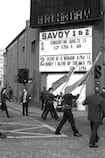
Once upon a time there was a faraway land called the North, where the only tourists from the South were Provos and press photographers and reporters. The North then was the kind of place that people from the South not only never visited but also never mentioned. It just didn’t come up in normal conversation. It was our “up there”, the equivalent of the bodily “down there” and so unmentionable in civilised society.
Sometime in the mid to late 1960s, when I was still in short trousers, I did in fact get up north, on a school trip. We went a bit mad, buying banned sweets such as Mars bars, and gorging on Wall’s ice creams, all unobtainable down south, like condoms, though we wouldn’t have had a notion what they were.
Other than that there were a couple of nervous trips through Aughnacloy, in Co Tyrone, on family holidays to Co Donegal, where we could feel through our bottoms the transition from rough southern roads to smooth northern tarmac, in a Volkswagen Beetle laden down with holiday stuff on the roof and current dog at my mother’s feet.
We played spot the difference: red postboxes, neater hedges, tidier towns, different uniforms, a different order to things.
My next visits north came in the early 1980s, working as a photographer for the Irish Press, and then into the 1990s working for this newspaper. I was there always as a reaction to an event, or in place because something was expected to happen: the death of a hunger striker, perhaps, or funerals following an atrocity.
Like that of my colleagues, my presence was dictated by news. Every picture then either worked to deadline or didn’t work at all. By and large, the riots and events that were covered were the ones that left enough time to shoot, process, print and wire the images back to Dublin.
There were exceptions, such as Colman Doyle, of the Irish Press and Paris Match, and Gilles Peress, of Magnum, who realised that the bigger picture required a more sustained presence and who managed to persuade their editors of that need.
The rest of us, though, dived in and out to order, seeking strong single images that would carry the day. If we took other pictures on the sidelines – and I think we all did – we had no expectation that they would ever see the light of day.
Coming from that background, it is something of a delight to see Seán Hillen's book Melancholy Witness: Images of the Troubles. Hillen is a photographer and artist best known for his playful photocollage work Irelantis, poking fun at the myths of Ireland. In Melancholy Witness we see his images of the Troubles, some taken for use in his collage work but many taken for the best possible documentary motive: because they were there. The photographs now form part of the permanent collection of the National Library of Ireland.
Based between his native Newry and a London art college, Hillen steadily photographed events and, more importantly, nonevents from 1979 to 1992. The approach is that of an insider and also an outsider. He was an insider to the extent that he grew up in the nationalist tradition, but when shooting he would have been regarded as an outsider both by the mainstream media and by many of his subjects, certainly on the unionist side.
The style is documentary black and white in the Cartier-Bresson tradition, and the captions are refreshingly anecdotal rather than formal. Here we have a wonderfully random collection of images as the photographer documented elements of the H-block campaign and the hunger strikes, including, memorably, the Patsy O’Hara funeral and subsequent rioting. But here among the gladiatorial entertainment of riots are parades from both sides of the divide, a fascinating Good Friday ceremony in the Mournes and the terrible fashions of the land that time forgot.
Totems and symbols abound: wire, corrugated iron, flags, broken glass, burnt-out cars and buses, ice creams and lollipops, dodgy hairstyles, peeling paint, amended billboards, cut-off denims, observation towers, helicopters, soldiers, Celtic scarves, people on walls and rooftops, graffiti. All are symbols that might make you groan except that they exist here in a gentler historical context, taken in a style that is as ironic, wistful and human as it is melancholy. These are the in-between pictures of Up There that you never got to see in mainstream coverage.
For all the right reasons, while leafing through this book a saying came to mind from the great Magnum photographer Elliott Erwitt: all the technique in the world doesn't compensate for an inability to notice. This volume is something of a gem. In a world of image overload it represents a triumph of substance over technique. The work deserves the attention of all of us from Down Here who seldom or never went Up There in the 1970s, 1980s and 1990s.
Frank Miller is a staff photographer and picture editor at The Irish Times.








